I've spent the lion's share of the last eight years living in China, crisscrossing the country in search of amazing food. And if my travels have taught me anything, it's that Chinese cuisine bears only a passing resemblance to the dishes most Westerners think of – China is home to a magnificently diverse culinary landscape, with a range of complex and varied flavors hailing from each of its 23 provinces, five autonomous regions, and 56 ethnic groups.
Picking and choosing the best dishes from such a vast spectrum is, of course, impossible. Instead, I've decided to look back and consider the flavors I pursued most passionately and the ones I remember most vividly. From the tart-sour fruit yang mei, which I devoured in Yunnan, to the savory blood tofu that's a specialty of Guizhou province, these are the 15 most memorable bites, tastes, and sips I encountered on my travels, along with tips for locating the best versions if you're lucky enough to find yourself in China.
MEIGANCAI (DRY PICKLED MUSTARD GREENS)
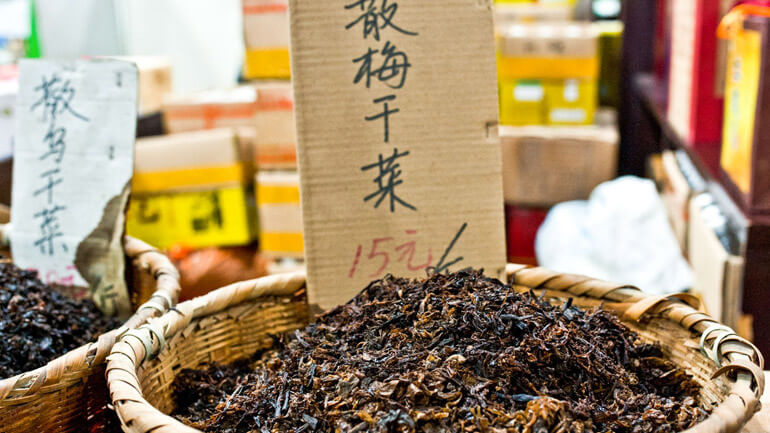
Wrinkled and deep brown, meigancai looks more like soft, dark tobacco than a cooking ingredient at first glance. But one sniff of its strong, beefy aroma is enough to hint at its culinary potential. The salted, fermented, dried, and aged mustard green is a specialty of China's eastern city of Shaoxing, where it's sold in the tiny wine shops and dry-goods stores that line Canqiao Straight Street. Thanks to its intense umami character, the pickled green is right at home in Shaoxing's local cuisine, which is abundant with foods like fermented amaranth, stinky tofu, dried fish, and rice wine, each with its own uniquely savory flavor. I first tasted meigancai in a dish of slow-cooked pork belly – the luscious sweetness and soft texture of the belly fat contrasting with the rich saltiness and yeasty aroma of the fermented green. But it's also a not-so-secret key ingredient in countless preparations, with wisps of its dark leaves deepening the flavor of steamed baozi and crisp flatbreads, and small handfuls adding nuance to soups and braises.
SHAOXING WINE
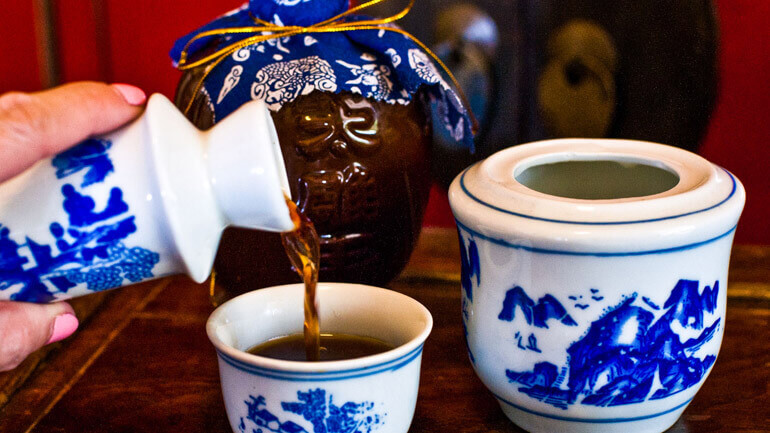
Shaoxing is known for its mist and rain, its ancient canals crossed with stone bridges, and the best traditional rice wine in China. I first tried the latter in one of the city's old wine shops, surrounded by tall jars filled with aged wines. There, it was served from a small ceramic flask that was warmed in a bath of hot water to enhance the drink's aroma and flavor – perfect for sipping on a cold, damp winter day.
Given its long history, it's no surprise that variations abound. The wine, made by fermenting glutinous rice with wheat and aging it in deep earthenware vessels for up to several decades, can be anywhere from light amber to deep brown in color. And, though a slight raisiny sweetness and mellow sherry-like flavor are typical, the wine ranges from quite dry to extremely sweet. Do note that none of the legit stuff tastes a bit like the abominable liquors that pass for Shaoxing wine in supermarkets – beware the cheap, salted versions sold as "cooking wine," and instead pay a visit to a specialty wine purveyor or a reputable Chinese market. A good bottle will have been aged for at least five years and cost a minimum of $10. Once you've got your hands on true Shaoxing wine, make the most of it, incorporating it into your cooking and sipping it on its own.
HAIRY CRAB
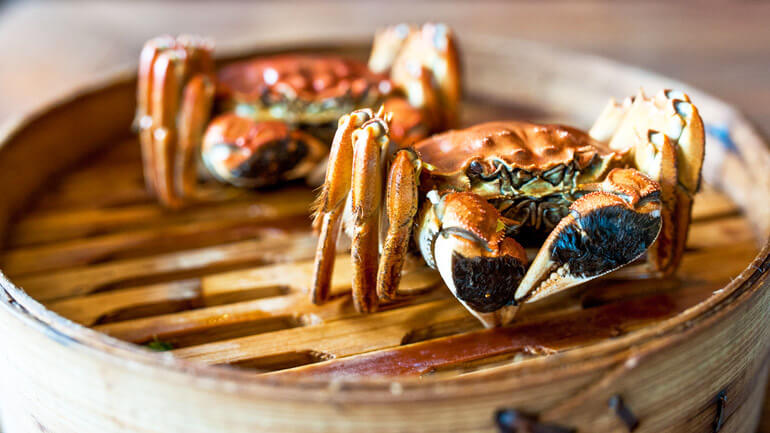
There is one single seasonal delicacy prized by Shanghai's food lovers above all others: the sweet flesh and creamy roe of the hairy crab. In the first crisp days of early autumn, Shanghai locals start to pester their vendors at the wet market (the common term for a fresh meat and produce market), and, once hairy crab season starts in earnest, it's a nonstop three-month-long feast. The best crabs, with fluffy black mittens on the ends of their claws, appear early – in the ninth lunar month for females, when the roe is at its peak, and in the 10th lunar month for males, when the flesh is at its sweetest. I've always found them something of a fiddly nightmare to eat, but the roe, which stains your lips and fingers yellow, is a worthy prize: astoundingly rich, with the flavor of a just-coddled egg yolk.
The usual accompaniment to the crab is Shaoxing wine, said to perfectly balance the cooling properties of the crab in traditional Chinese medicine. It's hard to beat dining on hairy crab in one of the many restaurants perched on stilts around the edge of Yangcheng Lake, an hour northwest of Shanghai, where it's claimed the best crabs are found – heavy for their size, with the flesh clean and the females full of roe. On a clear autumn day, the lake is gloriously dark blue, and you can drink cold beer (or warm Shaoxing wine) sitting outside at a plastic-covered table. Some of these spots will even undertake the mess and bother for you, removing the meat and discarding the shells. Then again, where's the fun in that?
XIAO LONG BAO (SOUP DUMPLINGS)
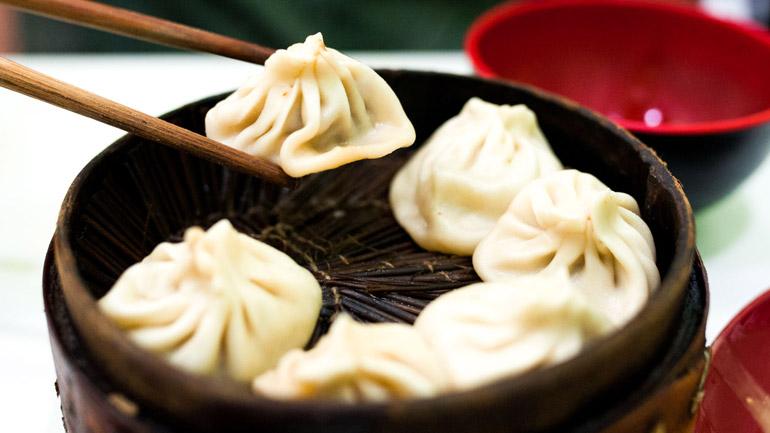
Xiao long bao, those miraculous constructions of delicate dumpling wrappers encasing a big slurp of hot, savory soup and sweet, fragrant ground pork, are far and away my favorite Chinese street food. The pocket of soupy stock is the dumpling's essential element: a flavored pork aspic, typically made with pork skin, chicken bones, ginger, scallions, and Shaoxing wine, simmered for hours until the collagen-heavy ingredients have turned to gelatin, and then cooled until it sets. The dumplings arrive steaming and dangerously hot – to eat one, you have to decide whether to nibble a hole in it first, releasing the steam and risking a spill, or throw caution to the wind and pop the whole dumpling in your mouth, a burst of near-scalding broth exploding on your tongue.
Shanghai may be the recognized home of the soup dumpling, but food historians will actually point you to the neighboring ancient canal town of Nanxiang as xiao long bao's birthplace. There, you'll find them rustically prepared – more dumpling and less soup – and the wrappers are pressed by hand rather than rolled, for a thicker and heartier dough.
Nanxiang aside, the best xiao long bao have a fine, almost translucent skin, allowing them to be lifted out of the steamer basket without tearing or spilling any of their contents. The meat should be savory with a touch of sweetness, and the surrounding broth hot, clear, and aromatic with pork, ginger, and Shaoxing wine. Most vendors serve them with tangy, dark Zhenjiang vinegar and slivers of fresh ginger to complement the sticky-rich soup, though you'll also find them served alongside a bowl of clear soup. If you're lucky enough to be in China during hairy crab season, you can also find the pork mixed with the meat and roe of the crab, for an even sweeter, richer filling.
SIU MEI (CANTONESE BARBECUED MEAT)
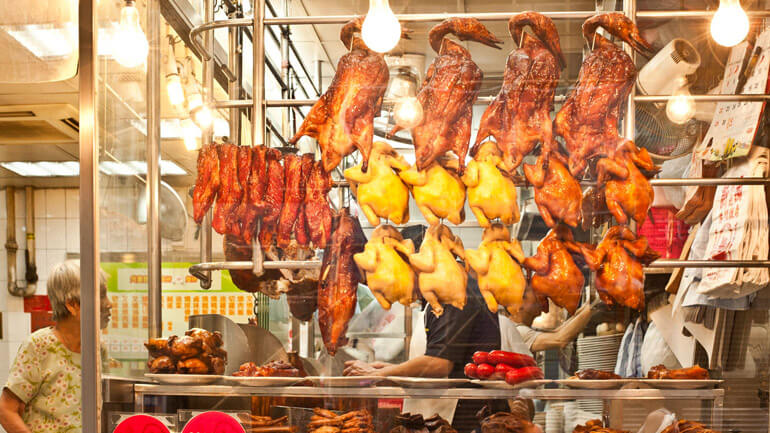
Whenever I walk the streets of Hong Kong, I can't help myself – if I pass a barbecue shop, I have to go in and eat. The gloss on the roast ducks and pigeons gleams under the incandescent heat lamps, amid crisp-crusted pork, goose, soy-marinated chicken, and cuttlefish. The hanging delicacies – mahogany, gold, burnished, and fragrant with five-spice powder – await the sharp thwack of the cleaver as the vendor chops your chosen meat into pieces and serves it over rice with a sticky-sweet sauce. Ignore the grubby laminated tabletops and rough chopsticks sitting in a plastic cup. If the shop is filled with locals on their lunch breaks, and if a steady stream of customers arrives for takeaway siu mei to eat at home, then you're in the right spot. Sheung Wan district has some of the best, and its streets are great for wandering, with the enormous indoor wet market on Morrison Street and the nearby shops selling premium teas and abalone that's often spread out in the sun to dry.
FRESH TOFU
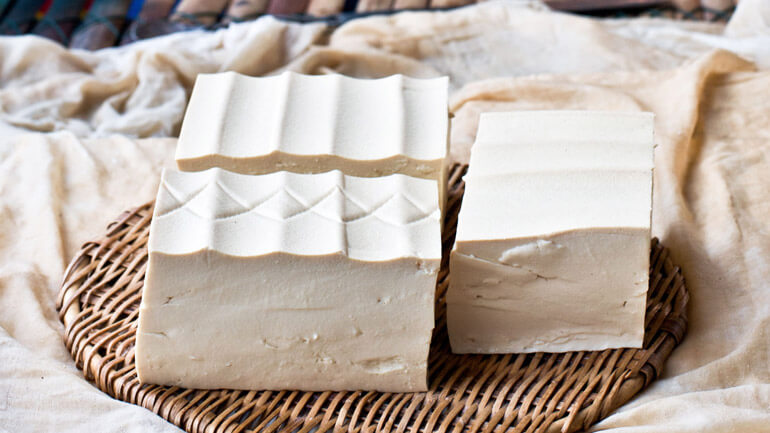
Until I lived in China, I had only ever tasted vacuum-packed, rubbery, tasteless supermarket tofu – the kind that lasts for months in the refrigerator. I consumed it, resentfully, during a brief vegetarian phase in my early 20s, and never again. But eating homemade tofu, warm and lightly steaming, sliced on its muslin wrapping cloth with a worn and hefty cleaver, is a revelation. The texture is smoother than the finest ricotta; the aroma comforting and beany; the flavor light, with fresh soybean overtones. It's so fragile, so delicate and quivering, that if you don't eat it immediately, you have to keep it floating in a water bath to cushion it from injury. Locals buy their tofu in the morning, when it's freshest, and cook it the same day. Finding fresh tofu in China isn't challenging, as it's made everywhere. But for the best homemade tofu, you'll need to go into the countryside, to an open-air market.
CRYSTAL SUGAR HAWTHORNS
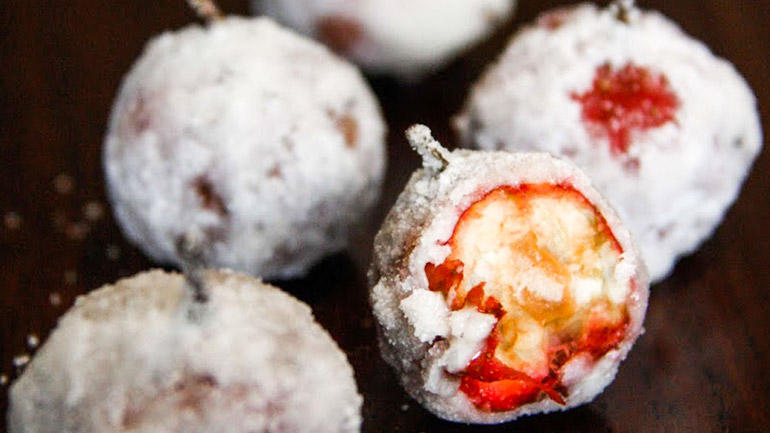
The arrival of winter means that hawthorns – which are related to rose hips – are in season. The round red berries have a cream-colored flesh with a flavor close to that of a tart green apple, peppered with dark brown seeds. They're found in China's colder provinces, north of the Yangtze. Because they're so astringent, hawthorns are often paired with something sweet. Some string them together on sticks and roll them in toffee, like a row of red lanterns or tiny candied apples – a preparation called bingtang hulu. But I prefer them lightly oiled, then coated in confectioners' sugar. These bingtang shanzha, or crystal sugar hawthorns, are downright addictive, with a crisp, white crust that packs a satisfying sweet-sour punch.



 闽公网安备 35020302035673号
闽公网安备 35020302035673号
0 responses on "15 tasty foods you should try in China (1)"